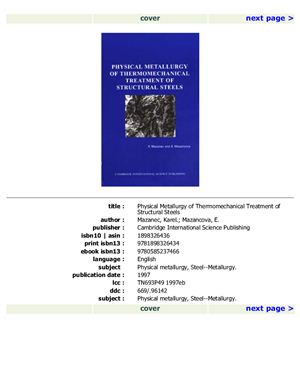Cambridge Inteational Science Publishing, 1997, 143 Pages, ISBN:
1898326436
The main feature of TMT is that the plastic deformation of the initial austenitic matrix and the formation of its controlled structural and mechanical state with subsequent heat treatment, phase transformation, are linked. This link makes it possible to utilize the hardening or refining of the grains of the initial austenitic matrix and also utilize the structural modification of the products of phase transformation of austenite associated with the modification of structural and substructural characteristics of the austenitic matrix leading to higher mechanical and metallurgical properties of various types of structural steel processed by this treatment. The book summarizes the results obtained in extensive research of the hardening characteristics of metallic materials (structural steels), with special attention given to the problems of the physical metallurgy nature of hardening of martensitic steels and control-rolled structural steels or structural steels subjected to subsequent accelerated cooling and used for wider technical applications. Taking this analysis into account, selected problems, whose solution leads to obtaining optimized technical and technological conditions of processing these types of steel by the selected unconventional heat treatment method, will also be discussed.
Main Physical Metallurgy Characteristics of Thermomechanical Treatment
Thermomechanical Treatment of High-Strength Martensitic Steels
Thermomechanical Treatment and Controlled Rolling of Carbon and Low-Alloy Steels
The main feature of TMT is that the plastic deformation of the initial austenitic matrix and the formation of its controlled structural and mechanical state with subsequent heat treatment, phase transformation, are linked. This link makes it possible to utilize the hardening or refining of the grains of the initial austenitic matrix and also utilize the structural modification of the products of phase transformation of austenite associated with the modification of structural and substructural characteristics of the austenitic matrix leading to higher mechanical and metallurgical properties of various types of structural steel processed by this treatment. The book summarizes the results obtained in extensive research of the hardening characteristics of metallic materials (structural steels), with special attention given to the problems of the physical metallurgy nature of hardening of martensitic steels and control-rolled structural steels or structural steels subjected to subsequent accelerated cooling and used for wider technical applications. Taking this analysis into account, selected problems, whose solution leads to obtaining optimized technical and technological conditions of processing these types of steel by the selected unconventional heat treatment method, will also be discussed.
Main Physical Metallurgy Characteristics of Thermomechanical Treatment
Thermomechanical Treatment of High-Strength Martensitic Steels
Thermomechanical Treatment and Controlled Rolling of Carbon and Low-Alloy Steels

